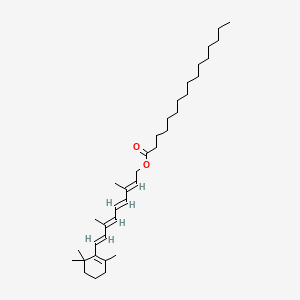| MeSH term | MeSH ID | Detail |
|---|---|---|
| Edema | D004487 | 152 associated lipids |
| Weight Gain | D015430 | 101 associated lipids |
| Cell Transformation, Neoplastic | D002471 | 126 associated lipids |
all-trans-retinyl Palmitate
All-trans-retinyl palmitate is a lipid of Prenol Lipids (PR) class. All-trans-retinyl palmitate is associated with abnormalities such as Wiskott-Aldrich Syndrome.
Cross Reference
Introduction
To understand associated biological information of all-trans-retinyl Palmitate, we collected biological information of abnormalities, associated pathways, cellular/molecular locations, biological functions, related genes/proteins, lipids and common seen animal/experimental models with organized paragraphs from literatures.
What diseases are associated with all-trans-retinyl Palmitate?
all-trans-retinyl Palmitate is suspected in and other diseases in descending order of the highest number of associated sentences.
Related references are mostly published in these journals:
| Disease | Cross reference | Weighted score | Related literature |
|---|
Possible diseases from mapped MeSH terms on references
We collected disease MeSH terms mapped to the references associated with all-trans-retinyl Palmitate
PubChem Associated disorders and diseases
What pathways are associated with all-trans-retinyl Palmitate
There are no associated biomedical information in the current reference collection.
PubChem Biomolecular Interactions and Pathways
Link to PubChem Biomolecular Interactions and PathwaysWhat cellular locations are associated with all-trans-retinyl Palmitate?
There are no associated biomedical information in the current reference collection.
What functions are associated with all-trans-retinyl Palmitate?
There are no associated biomedical information in the current reference collection.
What lipids are associated with all-trans-retinyl Palmitate?
There are no associated biomedical information in the current reference collection.
What genes are associated with all-trans-retinyl Palmitate?
There are no associated biomedical information in the current reference collection.
What common seen animal models are associated with all-trans-retinyl Palmitate?
There are no associated biomedical information in the current reference collection.
NCBI Entrez Crosslinks
All references with all-trans-retinyl Palmitate
Download all related citations| Authors | Title | Published | Journal | PubMed Link |
|---|---|---|---|---|
| Zachman RD et al. | Use of the intramuscular relative-dose-response test to predict bronchopulmonary dysplasia in premature infants. | 1996 | Am. J. Clin. Nutr. | pmid:8604659 |
| Schalinske KL and Steele RD | Carbon flow through the hepatic folate-dependent one-carbon pool is not altered in vitamin A-deficient rats. | 1996 | J. Nutr. | pmid:8598552 |
| Twining SS et al. | Effect of vitamin A deficiency on the early response to experimental Pseudomonas keratitis. | 1996 | Invest. Ophthalmol. Vis. Sci. | pmid:8595951 |
| Honour S et al. | Vitamin A status of wild mallards (Anas platyrhynchos) wintering in Saskatchewan. | 1995 | J. Wildl. Dis. | pmid:8592347 |
| Honour SM et al. | Experimental vitamin A deficiency in mallards (Anas platyrhynchos): lesions and tissue vitamin A levels. | 1995 | J. Wildl. Dis. | pmid:8592346 |
| Winklhofer-Roob BM et al. | Response to oral beta-carotene supplementation in patients with cystic fibrosis: a 16-month follow-up study. | 1995 | Acta Paediatr. | pmid:8563224 |
| Crabtree DV et al. | Vitamin E, retinyl palmitate, and protein in rhesus monkey retina and retinal pigment epithelium-choroid. | 1996 | Invest. Ophthalmol. Vis. Sci. | pmid:8550335 |
| Reznik Y et al. | Postprandial lipoprotein metabolism in normotriglyceridemic non-insulin-dependent diabetic patients: influence of apolipoprotein E polymorphism. | 1996 | Metab. Clin. Exp. | pmid:8544779 |
| Azaïs-Braesco V et al. | Vitamin A contained in the lipid droplets of rat liver stellate cells is substrate for acid retinyl ester hydrolase. | 1995 | Biochim. Biophys. Acta | pmid:8541334 |
| Recchia F et al. | Sequential chemotherapy, beta interferon, retinoids and tamoxifen in the treatment of metastatic breast cancer. A pilot study. | 1995 | Eur. J. Cancer | pmid:8541122 |
